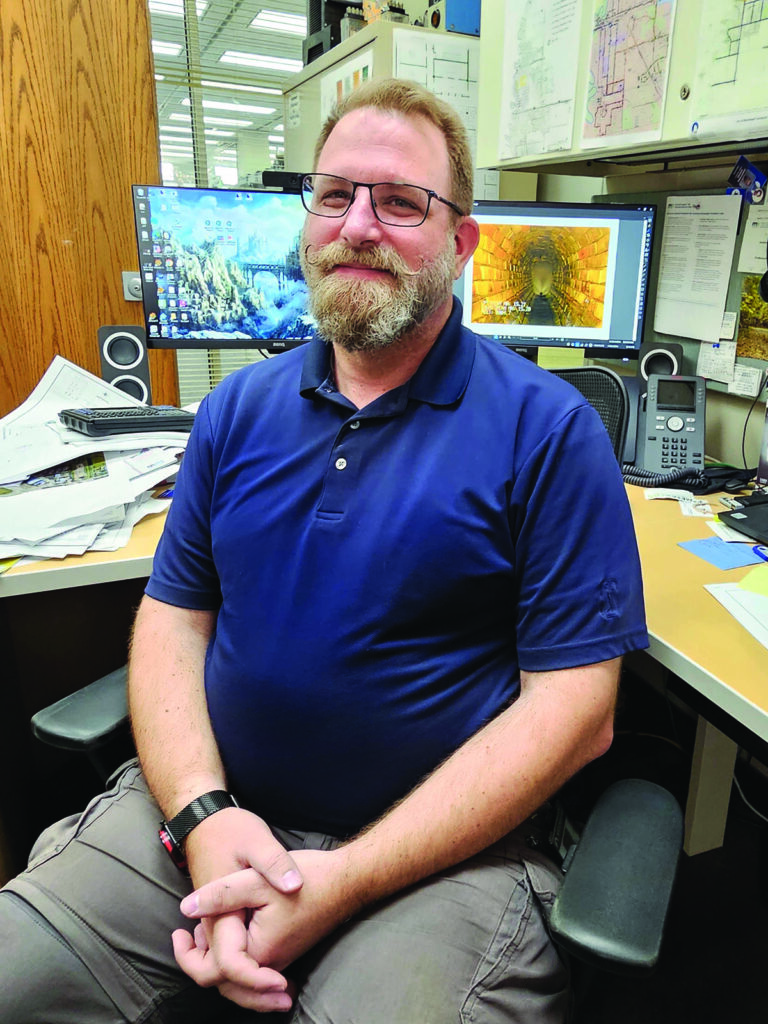Nancy Edmonds Hanson

Engineer Jonathan Atkins. (Photo/Nancy Hanson)
Some of the oldest structures in Moorhead are unseen and underfoot. That’s where a major construction project will be finishing up this summer – 25 feet down, in the venerable hand-built brick sewers that have served the city well for the past 90 years.
For the third consecutive summer, the brick-and-mortar sewers constructed during the Great Depression will be getting new fiberglass linings impervious to the wastewater than flows through them to the Moorhead Wastewater Treatment Facility on the north side of the city. Re-fitting the lines with the durable inner tubes began in 2021 and continued last year, creating some major traffic disruptions in the downtown area. This year, city traffic engineer Jonathan Atkins predicts the impacts will be considerably less.
“We’d hoped to get the project done last year, but the sheer scope of what’s being done forced it to be carried over,” he says. About half of the 7,000 feet, or 25 blocks, of brick sewers were finished in 2022. “We’re going to do our best to keep traffic lanes open.” Much of the work will be carried out down in the sewer line … by robotic equipment. Some above-ground work is unavoidable, though, including replacing the tops of manholes along Main Avenue, widening the cone at the top of the access points. Three temporary bypass pipes will also be added under the railroad tracks at Sixth, Eighth and Tenth Streets to remove the flow from the main sewer linese.
Back in the 1930s, employing workers to build sewers downtown with bricks and mortar was not only a way to put economically battered men to work – it was the latest and greatest technology available. The oval 46-inch tunnel deep below the surface of the streets was something of an engineering marvel in its day, when it originally carried both sewage and natural run-off. The systems were separated 70 to 80 years ago.
Those Depression-era laborers’ handiwork has served the city well. Newer, smoother fiberglass liners, however, smooth the flow. The liners have already been used for the past 20 years to line 50,000 feet of vulnerable clay sewer lines installed in the 1950s and 1960s. Newer neighborhoods make use of polyvinyl chloride (PVC) pipe.
The relining process eliminates major excavation of the deeply buried lines. Work within the sewers takes advantage of the space-age alternatives that replace human workers. “Methane gas is generated by sewage, and it’s deadly,” Atkins explains. “We always have to ventilate before someone goes down.” Even then, workers are outfitted with cables attached to a tripod aboveground so that if they’re overcome, they can be cranked up to the surface.
After the manholes are enlarged to accommodate it, robotic equipment first cleans the interior of the lines with a high-pressure hose, basically scouring it of invading roots and protrustions. “It cuts them like a knife,” the engineer reports. “The wash water goes right back into the sewer, and it’s all carried away.”
Then a camera and laser are sent down to explore and document the inner walls in exquisite detail. Carried on a sort of trolley, they precisely map the sewer’s interior, recording all the imperfections that hand construction inevitably leaves behind.
The data is sent to the factory where the fiberglass liners are built to their exacting measurements. Finally, the fabricated liners journey back to Moorhead for installation.
Atkins describes them as “like a sock – an inside-out sock.” The sections are from 300 to 800 feet in length, matching the distance between manholes.
“These fiberglass socks have resin embedded in their fibers,” he explains. “When they’re brought into the lines, air pressure folds them right-side-out. It pushes them up against the edges of the brick surface. Then the tunnel is filled with hot, hot steam for a day or two to cure them – to set the resin off. It sets up and goes super-hard like epoxy.”
The last step is one that may briefly interrupt the ability to flush along Center and Main Avenues and Fourth Avenue North. The liner must be breached to allow the feeder lines to empty into it. “A second robot does the work with a hole saw,” Atkins notes. “It knows the exact locations and angles where the cuts have to go.”
As the city’s traffic engineer, Atkins’ mission is to prevent as much disruption as possible. “We’ll explain the reasons when it has to be closed, and only do it when it’s absolutely necessary,” he vows. Residents can receive email updates as the project progresses by subscribing to city notifications or updating current notification categories at https://www.cityofmoorhead.com/about-the-city/news/sign-up-for-e-notification/


